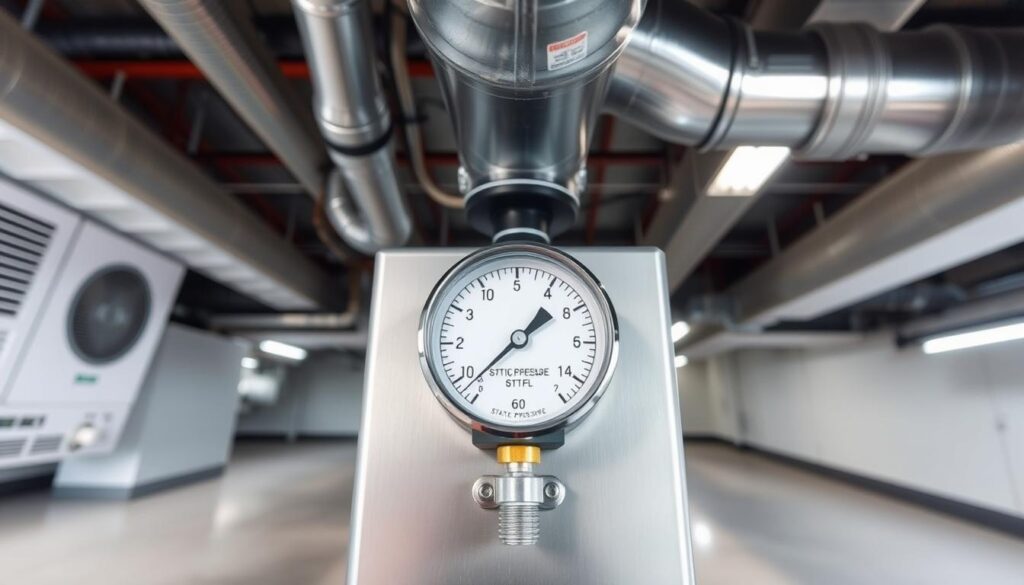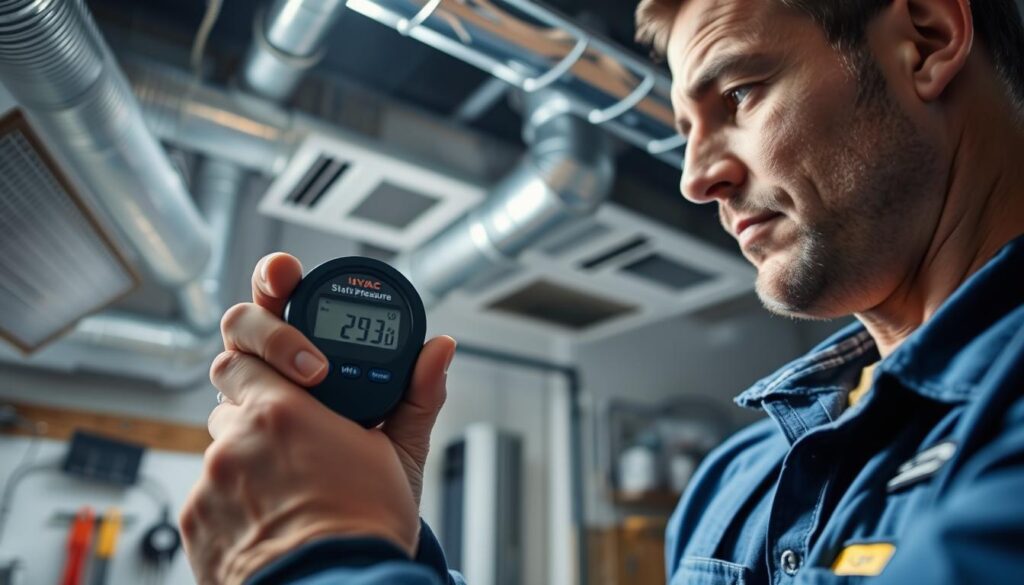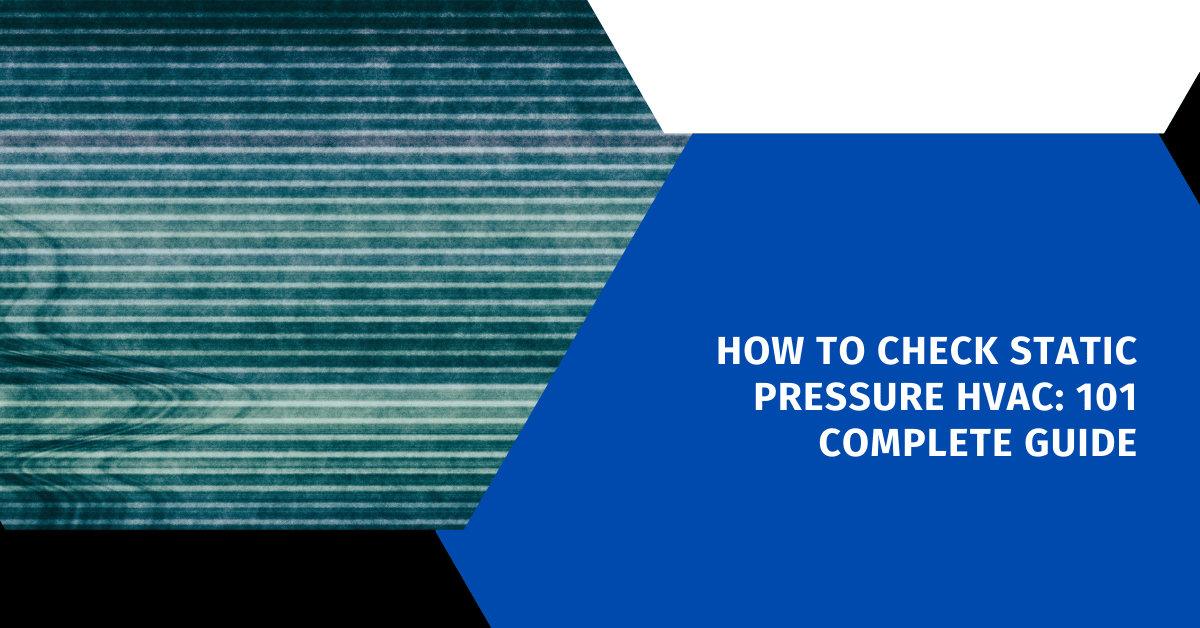Affiliate Disclosure
HVAC Guide Guys is a participant in the Amazon Services LLC Associates Program, an affiliate advertising program designed to provide a means for sites to earn advertising fees by advertising and linking to Amazon.
How to Check Static Pressure HVAC? Static pressure is the resistance to airflow in your heating and cooling system. Knowing how to check it can make your home more comfortable and save energy.

Are you having trouble with your home’s heating and cooling? Maybe the problem is something you can’t see: static pressure in your HVAC system?
This guide will show you how to measure HVAC static pressure. You’ll learn important techniques, how to diagnose issues, and how to keep your system running well.
Key Takeaways
- Static pressure directly impacts HVAC system efficiency
- Proper measurement requires specialized tools and techniques
- Regular static pressure checks prevent potential system failures
- DIY testing is possible with proper knowledge and equipment
- Professional assessment offers the most accurate results
Table of Contents
Understanding Static Pressure in HVAC Systems
Static pressure is key for your home’s heating and cooling. It shows how well air moves through your ducts. It also checks your HVAC’s health.
Static pressure is like water in a pipe. The more resistance, the harder your system works. This is because of air resistance in HVAC systems.
Basic Principles of Air Resistance
Air resistance in HVAC systems comes from a few main things:
- Duct design and configuration
- Filter restrictions
- Coil and equipment layout
- Potential blockages or obstructions
Impact on System Performance
High static pressure can hurt your HVAC system’s performance. High readings mean:
- Less airflow
- More energy use
- Uneven temperatures
- Possible damage to equipment
Key Components Affected by Static Pressure
Many important parts of your HVAC system are affected by static pressure:
- Blower motors: Work harder to push air through tight spots
- Air filters: Become main resistance points
- Heat exchangers: Work less efficiently
- Compressors: Face extra stress
Knowing about these effects helps keep your HVAC system running well. Regular checks and expert advice can stop problems early.
Explore Our HVAC Shop
Looking for top-rated HVAC tools, parts, and accessories? Visit our shop and find the perfect solution for your needs.
Visit the ShopEssential Tools and Equipment for Measuring Static Pressure
Measuring static pressure in HVAC systems needs special tools. These tools help technicians check how well the system works. The main tool is a manometer for static pressure. It gives exact readings of air resistance in your heating and cooling system.
- Digital static pressure gauge
- Analog manometer
- Static pressure probes
- Drill bits for test holes
- Protective safety equipment
There are two main types of static pressure gauges: digital and analog. Digital gauges give quick, easy-to-read measurements and are very accurate. Analog manometers offer a traditional way to test pressure.
| Tool Type | Accuracy | Ease of Use | Price Range |
|---|---|---|---|
| Digital Manometer | High | Very Easy | $100-$500 |
| Analog Manometer | Medium | Moderate | $50-$200 |
Professional HVAC technicians say it’s smart to get a good manometer for static pressure. Your gauge should be able to measure pressure in inches of water column. This is the standard unit for checking HVAC systems.
Always calibrate your tools often and follow the maker’s instructions. This way, you’ll get accurate readings during your static pressure tests.
How to Check Static Pressure HVAC
Checking static pressure in your HVAC system is key to its performance and efficiency. It requires careful preparation and precise measurements. This helps spot any airflow issues.
- Digital manometer
- Drill with the right bit
- Measuring tape
- Protective safety gear
Preparing Your System for Testing
First, turn off your HVAC system. Find the right test points. You’ll need to make small holes in the air ducts for your tools. Make sure the system is off before drilling.
Step-by-Step Measurement Process
- Find test spots near the air handler
- Drill 1/4-inch holes carefully
- Put manometer probes in the holes
- Turn the system on at normal settings
- Take pressure readings from both sides
Recording and Interpreting Results
Add the supply and return pressure measurements to get the total static pressure. Most homes should have a total between 0.5 and 0.7 inches of water column. If your readings are off, it might mean airflow problems or system issues.
Professional HVAC technicians say to test static pressure yearly to keep your system running well.
Explore Our HVAC Shop
Looking for top-rated HVAC tools, parts, and accessories? Visit our shop and find the perfect solution for your needs.
Visit the ShopProper Test Hole Locations for Different HVAC Configurations
Knowing the right spots for test holes is key for accurate readings of hvac duct static pressure. Each HVAC setup needs a unique way to measure airflow static pressure.
For static pressure tests, finding the exact spots is crucial. The right placement of test holes greatly affects your measurement’s accuracy.
- Upflow Gas Furnaces: Measure before and after the filter
- Downflow Gas Furnaces: Test near return and supply air openings
- Horizontal Furnaces: Check pressure at filter and coil locations
- Rooftop/Package Units: Evaluate pressure at multiple system points
Every HVAC setup has its own test challenges. Experts suggest specific methods for a thorough system check.
| HVAC System Type | Primary Test Hole Locations | Recommended Measurement Points |
|---|---|---|
| Upflow Furnace | Return air inlet | Before and after filter |
| Downflow Furnace | Supply air outlet | Near heat exchanger |
| Horizontal System | Duct connections | Coil and filter areas |
| Rooftop Unit | Multiple duct sections | Inlet and outlet points |
Pro tip: Always use calibrated tools and follow the maker’s advice for airflow static pressure tests. This ensures your results are spot on.
Choosing the right test hole spots helps find and fix HVAC system problems. It also shows where maintenance or tweaks might be needed.
Understanding Static Pressure Readings and Normal Ranges
Knowing about hvac static pressure readings is key to keeping your HVAC system running well. Airflow static pressure measurement helps spot problems and check if your system is working right.
Static pressure is how hard air has to push to get through your HVAC system. Experts use special tools to check this important number.
Ideal Pressure Ranges
Every HVAC system needs a certain pressure level. For homes, the best static pressure is usually between:
- 0.3 to 0.5 inches of water column for supply side
- 0.2 to 0.4 inches of water column for return side
Warning Signs of Abnormal Readings
Spotting odd static pressure readings can stop big problems. Keep an eye out for these signs:
- Pressure over 0.5 inches of water column
- Uneven airflow in different rooms
- Strange noises when the system is on
System-Specific Considerations
The age, design, and setup of your HVAC system affect static pressure. Things like duct size, length, and how efficient the equipment is matter a lot.
| System Type | Recommended Static Pressure Range |
|---|---|
| Residential Split System | 0.3 – 0.5 inches WC |
| Commercial Rooftop Unit | 0.5 – 0.7 inches WC |
| High-Efficiency System | 0.2 – 0.4 inches WC |
Getting a pro to check your hvac static pressure readings is the best way to make sure your system is working its best.
Common Causes of High Static Pressure

Understanding the causes of high static pressure in HVAC systems is key. It helps keep your system running well. High static pressure can hurt your system’s performance and lifespan.
Several factors can lead to high static pressure in HVAC systems:
- Undersized Ductwork: Narrow or wrong ducts block airflow
- Excessive Duct Bends: Sharp turns and angles slow air down
- Dirty Air Filters: Clogged filters make the system work harder
- Blocked Vents and Registers: Stopped airflow builds up pressure
“A well-designed HVAC system should minimize resistance and maximize airflow efficiency.”
Equipment that’s not the right size also causes problems. If your HVAC parts are too big or small, air doesn’t move right. This leads to uneven air flow and more resistance.
Other hidden causes include:
- Closed dampers that block air flow
- Zoning system problems
- Debris in ductwork
Finding these common causes helps avoid system failures. It also cuts down on energy use.
Explore Our HVAC Shop
Looking for top-rated HVAC tools, parts, and accessories? Visit our shop and find the perfect solution for your needs.
Visit the ShopImpact of Ductwork Design on Static Pressure
Your HVAC system’s performance depends on good ductwork design. Knowing how duct design affects static pressure helps improve system efficiency and avoid problems.
Good ductwork design is key to managing airflow and keeping static pressure in check. Bad duct design can really hurt your heating and cooling system.
Duct Sizing Principles
Getting duct sizing right means calculating airflow needs carefully. Important factors include:
- Room square footage
- Ceiling height
- Insulation levels
- Climate zone requirements
Common design Mistakes
Many HVAC systems face design issues that raise static pressure. Common mistakes include:
- Undersized duct cross-sections
- Too many sharp bends
- Bad transitions between duct sizes
- Not enough sealing
“A well-designed duct system can reduce energy consumption by up to 30%.” – HVAC Engineering Association
Optimization Strategies
To boost your HVAC system’s performance, try these tips:
- Choose smooth, round ducts when you can
- Reduce unnecessary bends and transitions
- Make sure insulation is right
- Check and seal duct connections often
Spending time on ductwork design can greatly improve your HVAC system’s efficiency and life span.
Static vs. Dynamic Pressure: Key Differences
Understanding pressure in HVAC systems is key for good airflow. Total pressure is made up of static and dynamic pressure.
Static pressure is the resistance when air is still. When measuring hvac static pressure, techs look at the force on duct walls. This shows how hard it is for air to move through the system.
Dynamic pressure happens when air moves. It’s the pressure from moving air and is important for system performance.
- Static Pressure: Resistance when air is stationary
- Dynamic Pressure: Pressure created by moving air
- Total Pressure: Combination of static and dynamic pressures
Experts use special tools to find these pressure types. Knowing static and dynamic pressure helps see how well your HVAC system works.
| Pressure Type | Characteristics | Measurement Focus |
|---|---|---|
| Static Pressure | Resistance to airflow | Duct wall force |
| Dynamic Pressure | Pressure from moving air | Air velocity |
| Total Pressure | Combined pressure | System-wide performance |
Knowing these differences helps find and fix HVAC problems. It also improves how well your system works.
Troubleshooting High Static Pressure Issues
When your HVAC system starts to have problems, high static pressure might be the cause. To fix it, you need a step-by-step plan to find and solve the issue.

Finding and fixing high static pressure takes a few key steps. Knowing what causes it helps avoid damage to your heating and cooling systems.
Diagnostic Approaches for Identifying Pressure Problems
- Conduct comprehensive pressure measurements across system components
- Use digital manometers for precise static pressure readings
- Inspect ductwork for potential blockages or restrictions
- Evaluate air filter condition and resistance
Strategic Solution Implementation
After spotting potential static pressure problems, here’s what to do:
- Clean or replace restrictive air filters
- Inspect and repair any damaged ductwork
- Verify proper equipment sizing
- Adjust fan speeds to optimize airflow
Fixing high static pressure needs a careful plan. Professional HVAC technicians say regular checks can catch problems early.
Proactive maintenance can prevent costly system failures and improve overall HVAC performance.
By using these steps, you can handle static pressure well. This keeps your HVAC system running smoothly and lasting longer.
Maintenance Tips to Prevent Static Pressure Problems
To stop static pressure problems in your HVAC, you need to take care of it regularly. This way, you can avoid expensive fixes and keep your system running well. Checking hvac static pressure readings is key to this.
Your HVAC system needs regular checks to keep air flowing smoothly. This helps avoid static pressure issues. By following good maintenance habits, you can lower the chance of problems.
- Replace air filters every 1-3 months
- Schedule professional HVAC inspections annually
- Clean air ducts and vents regularly
- Check and seal ductwork for air leaks
- Monitor how to check static pressure hvac performance
Experts say making a detailed maintenance plan is smart. It lets you catch any static pressure issues early. This way, you can fix them before they get worse.
| Maintenance Task | Frequency | Benefits |
|---|---|---|
| Filter Replacement | Every 90 days | Reduces static pressure buildup |
| Duct Cleaning | Annual | Improves air flow efficiency |
| Professional Inspection | Yearly | Comprehensive system assessment |
Investing in preventative maintenance can extend your HVAC system’s lifespan and optimize its performance.
Regular maintenance is your best defense against unexpected HVAC system failures and high static pressure issues.
Explore Our HVAC Shop
Looking for top-rated HVAC tools, parts, and accessories? Visit our shop and find the perfect solution for your needs.
Visit the ShopProfessional vs. DIY Static Pressure Testing
Homeowners often face a big choice: do they test their HVAC system themselves or call a pro? DIY testing might seem easy, but it’s not always the best choice. Knowing the differences is key to keeping your HVAC system running well.
DIY testing might be okay for simple systems. But, professionals have tools and knowledge that go way beyond basic tests.
- DIY Testing Capabilities:
- Basic pressure measurement tools
- Simple system checks
- Initial diagnostic screening
- Professional Testing Benefits:
- Advanced diagnostic equipment
- Comprehensive system evaluation
- Precise interpretation of static pressure test for hvac system results
For complex systems or ongoing problems, you really need a pro. They can spot issues that you might miss. This ensures your system works at its best.
Professional HVAC technicians provide insights beyond simple measurements, delivering comprehensive system health assessments.
It all depends on your situation. Simple, new systems might be fine with DIY. But, for older or complex systems, you need a pro to get it right.
Conclusion
Learning how to check static pressure in HVAC systems is key to keeping them running well. Your HVAC’s health relies on accurate pressure checks and regular upkeep. By using the methods from this guide, you can keep an eye on your system’s airflow.
Testing your HVAC system’s pressure is a great way to spot problems early. Regular checks can stop breakdowns, cut down on energy use, and make your equipment last longer. Whether you do it yourself or get a pro to help, you’ll see big improvements in how your system works.
Homeowners who learn about static pressure will enjoy better comfort and save on bills. Staying on top of maintenance and pressure checks can save you from expensive fixes. Remember, each system is different, so sometimes you might need a pro’s help.
With the tips from this guide, you’re ready to handle static pressure issues. Keeping an eye on things and acting fast is crucial for a strong, efficient HVAC system. This way, your system will work its best all year round.

